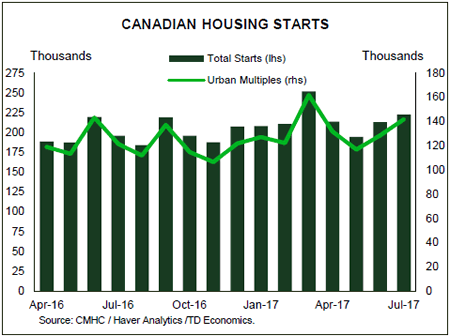U.S. Highlights
- Investors had lots to digest this week, with the lineup including communication from central banks, natural disasters and growing geopolitical tensions. The dynamics weighed on equities, while sending gold and Treasuries higher. Economic data remained largely positive, but diverging views among Fed officials point to some uncertainty.
- The October departure of Vice Chair Fischer is likely to add to that uncertainty.
- Economic data is likely to sustain some volatility due to the effects of Hurricane Harvey and the impending Hurricane Irma. Today’s swift deal in Congress to extend the government’s funding and borrowing limit until Dec. 8th, along with a $15.25 bn. relief package, should nonetheless provide some solace for the economy.
Canadian Highlights
- The GDP print was enough to sway the Bank of Canada to hike rates for the second consecutive meeting, with the move sending the loonie 2.4% higher on the week, 5% on the month, and 13.5% from its early-May trough.
- The stronger loonie has hampered exports which declined for the second time in July, with more weakness likely. Alongside the net export drag, residential investment is also likely to remain weak as Ontario markets cool-off.
- While not without blemishes, the employment report was a good one with the economy adding 22k jobs and the jobless rate down 0.1pp to 6.2%. The eroding labour market slack led to a pick-up in wage growth to 1.8% from a year-ago, providing some comfort for the Bank of Canada, with another hike still likely before the year is out.
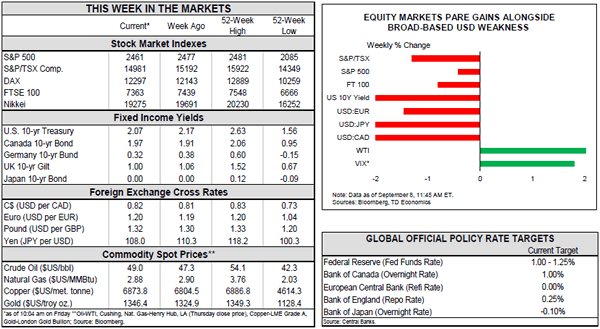
U.S. – More Stormy Weather And Volatile Data On The Horizon
Despite this being a holiday-shortened week, investors had lots to digest, with the lineup including communication from central banks, natural disasters and growing geopolitical tensions. The latter was the dominating factor at the start of the week, with markets opening on a dour note as investors poured into safe haven assets. The dynamic sent gold and Treasuries higher, while also benefitting crude oil. Conversely, long-term yields and the trade-weighted U.S. dollar sustained their downward trends – the latter falling to early 2015 levels.
Nonetheless, the theme of synchronized economic growth leading to a removal of monetary stimulus was back on display this week. An improved performance of the Eurozone and Canadian economies, which have been growing at rates significantly above potential lately, inspired more hawkish stances among their central banks. In this vein, the BoC hiked its key interest rate for the second time in two months, while the ECB began having ‘very preliminary discussions’ about how to scale back its €60 bn/month asset purchase program, with the process likely to start next year.
U.S. economic data was similarly positive. The trade deficit remained largely unchanged in July, and net exports are on track to contribute positively to economic activity for the third consecutive quarter. At the same time, the ISM non-manufacturing index followed its manufacturing counterpart and rebounded in August. The renewed vigor in both ISM metrics points to economic growth gaining momentum, with an upbeat tone in the Beige Book echoing a similar narrative. What is more, the prices paid components of both indices continued to point to rising price pressures (Chart 1). While we are yet to see these manifest in inflation metrics, the trend should still provide some comfort to the Fed as it meets to discuss monetary policy in two weeks’ time.
Ahead of that meeting, a number of speeches from Fed officials took place throughout the week. The most significant were those of voting members Brainard and Dudley. Brainard’s speech, which suggested treading carefully over low inflation, was decisively dovish. Meanwhile, Dudley retained a more hawkish tone, but did acknowledge his ‘surprise’ to the shortfall in inflation and suggested that ‘structural’ factors may be at play. The diverging views point to some uncertainty as to the near-term path of interest rates. The October departure of Vice Chair Fischer, at a time when the Fed Board already has three vacancies, is likely to add to that uncertainty.
This comes at a time when economic data is bound to go through some volatility due to the effects of Hurricane Harvey and the impending Hurricane Irma. Case in point, the weak August auto sales report has already been followed by a spike in jobless claims this week (Chart 2). The theme also played out in the Beige Book which, despite its upbeat tone, highlighted Harvey-related disruptions ahead. We expect these transitory effects to leave economic growth largely unchanged over the medium-term, but they will likely weigh on near-term economic activity. Today’s swift deal in Congress to extend the government’s funding and borrowing limit until Dec. 8th, along with a $15.25 bn. relief package, should nonetheless provide some solace.
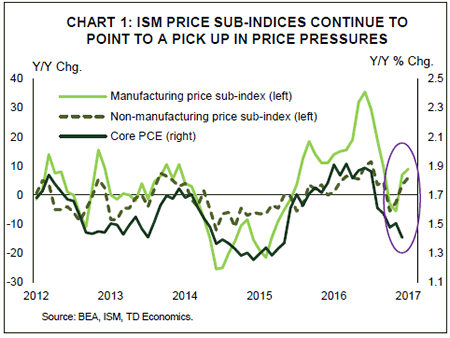
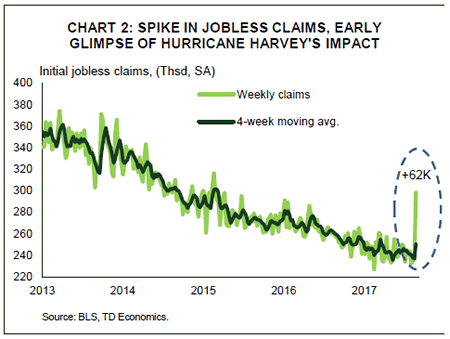
Canada – BoC Hikes On Strong Data, With More To Come
It was another busy week in Canadian markets. Last week’s blowout second quarter GDP number rapidly increased the chances of a near-term rate hike, and the Bank of Canada delivered. Since the chances of a hike were effectively a coin-toss, the rate rise drove bond yields up and lit a fire under the loonie. The Canadian dollar looks to finish the week 2.4% higher, marking a fourth consecutive week of gains vis-à-vis the greenback with the cumulative gain some 5% on the month. The loonie’s strength extends further than that, with robust Canadian data, and some broad-based weakness in the greenback, leaving the Canadian dollar a whopping 13.5% higher since its early-May trough.
The currency strength has begun to manifest on economic data. It has likely kept inflation down by about 0.2pp in recent months and has made Canadian exports more expensive on world markets. Trade data for July indicated a second consecutive decline with exports 1.6% lower July after a 3.0% decline in June. Moreover, the currency’s strength over August and September (so far) indicates that further weakness in exports is likely (see Chart 1), with trade likely to subtract from GDP over the third quarter, and perhaps even into the last quarter of the year. The trade numbers could be further affected by the persistent uncertainty related to the ongoing NAFTA renegotiations.
Another sector that’s likely to remain weak in the third quarter is residential investment. Monthly data from regional real estate boards this week indicated that both the Toronto and Vancouver markets saw sales pick-up in August from the previous month, ending four and three months of declines, respectively. However, third quarter sales activity is likely to remain very weak and together with lower prices will weigh on residential investment during the quarter.
Despite the softening in some sectors, much of the economy remains on a good course. The LFS employment report indicated that the jobless rate fell 0.1 pp to 6.2% – its lowest level since October 2008 – as the Canadian economy added a robust 22,200 jobs in August (Chart 2). It bears noting that this gain was due entirely to increases in part-time work. But, that caveat aside, the strength of job creation is beginning to show up in wage gains. The average hourly wage rose 0.5% on the month, and accelerating to 1.8% relative to a year ago.
The Bank of Canada’s most recent policy statement highlighted concerns over the "subdued" wage and price pressures. To that end, the acceleration in the wage growth in the August employment report is likely to provide some comfort with the hopes that wage growth will help lift inflation higher. The BoC will also likely discount any near-term weakness in inflation given the transitory effects of currency appreciation on consumer prices (also likely to be offset by Hurricane Harvey related impacts on gasoline prices). Lastly, the Bank is unlikely to be surprised by a slowdown in economic growth over the second-half of the year, which it fully expects according to the policy statement. As such, we believe another hike is very much possible before the year is out.
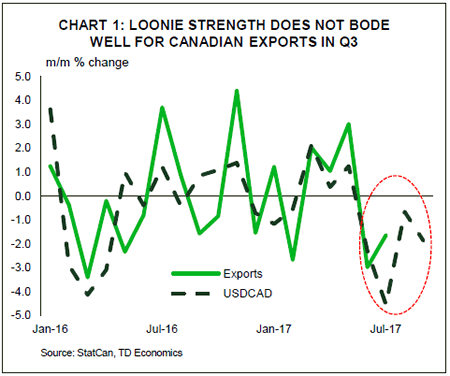
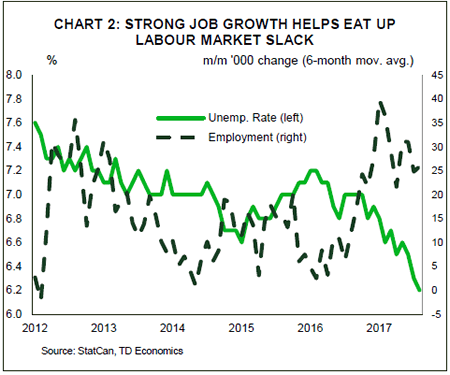
U.S.: Upcoming Key Economic Releases
U.S. Consumer Price Index – August
Release Date: September 14, 2017
Previous Result: 0.1% m/m, core 0.1% m/m
TD Forecast: : 0.4% m/m, core 0.2% m/m
Consensus: 0.3% m/m, core 0.2% m/m
We expect headline CPI inflation to pick up to 1.9% y/y in August, with prices up 0.4% m/m. Energy prices will be a significant boost this month following Hurricane Harvey, which shuttered about a quarter of the nation’s refinery output. We expect gasoline prices up nearly 6% m/m, with an even stronger increase in September. That would leave headline inflation on track to breach 2% y/y by October. In the core, we look for a return to a 0.2% m/m print (the first in six months) though unfavorable base effects leave the y/y rate lower at 1.6%. August gains should largely be driven by a rebound in hotel prices, which plunged in the prior two months. In addition, some further stabilization in core goods prices, led by apparel and presaged by higher import prices, along with steady strength in OER and rents should drive the pickup and offset a likely persistent drag from past categories of weakness, namely vehicle prices and wireless services. That said, we proceed with caution in the near term and continue to see risks skewed to the downside as the uncertain retail landscape suggests scope for more disappointment ahead. Further downside realized in core prices—in the form of 0.1% m/m prints in core CPI—will likely drive greater caution among Fed policymakers over future rate hikes.
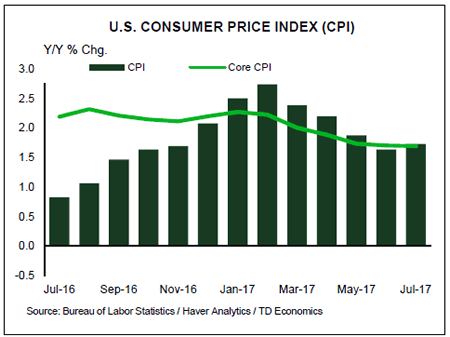
U.S. Retail Sales – August
Release Date: September 15, 2017
Previous Result: 0.6%, ex-auto 0.5%
TD Forecast: -0.1%, ex-auto 0.5%
Consensus: 0.1%, ex-auto 0.5%
We expect retail sales to fall 0.1% in August, led by a drop in motor vehicle sales. Light weight auto and truck sales disappointed at a 16.0m annual rate last month, in part due to the aftermath of Hurricane Harvey that hit Houston—the second largest auto market in the US. The August sales figure came in lower than analyst expectations, pointing to weaker Q3 real PCE closer to a mid to low 2% pace. Offsetting the August drop in auto sales are gasoline station receipts, reflecting a significant jump in gasoline prices. This should leave ex-auto sales up 0.5% and we also see scope for a healthy 0.3% increase in the control group (excluding auto, gasoline station, food services and building material sales). As such, the details will be more upbeat than the headline reading.
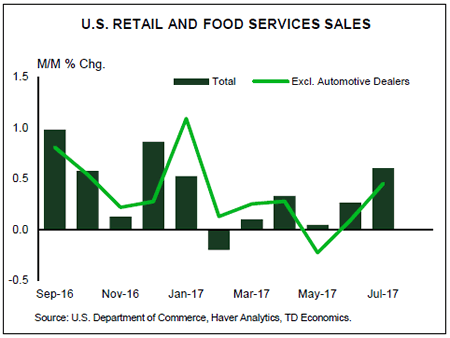
Canada: Upcoming Key Economic Releases
Canadian Housing Starts – August
Release Date: September 11, 2017
Previous Result: 222k
TD Forecast: 195k
Consensus: 215k
Housing starts should slow to an annualized 195k in August from the 222k pace the prior month. Since May, residential construction has bucked the downward trend in the wider housing market due to the strength of multi-unit starts. While much of the slowdown in housing has been contained to the Greater Toronto Area (GTA), we think this uncertainty coupled with the Bank of Canada’s decision to begin raising rates will start to weigh on the sentiment of developers. This was partially reflected in July building permits, where the value of permit issuance for multi-unit projects fell by 7.4% due to a sharp pullback in Toronto. As such, we expect most of the slowdown in residential construction to be concentrated in the multi-unit segment while single family construction could see a more modest deceleration towards 60k units.
